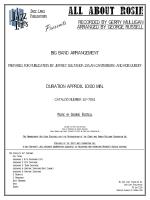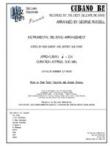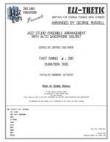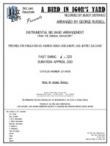ALL ABOUT ROSIE
Recorded by the Gerry Mulligan Concert Jazz Band
Arranged by George Russell, Prepared for Publication by Jeffrey Sultanof, Dylan Canterbury, and Rob DuBoff

Cat #: JLP-7061
$95.00This item usually ships within 1 business day.
Questions?
Please call +1-518-587-1102 or email us.
Edition: Jazz Big Band Arrangement
Description: Swing/Ballad - Advanced
Publisher: Jazz Lines Publications
To describe George Russell's All About Rosie in the simplest possible terms is to call it a jazz version of the classic song structure of theme and variations. To reduce it to such a basic description, however, is to do a great disservice to one of the most progressive compositions in the history of the music. Based, in the words of the composer, off of "a motif taken from an Alabama Negro children's song-game entitled 'Rosie, Little Rosie,'" the music sounds just as fresh, innovative, and exhilarating as it did when it was first composed in 1957. The version presented here is a re-arrangement of the piece that Russell wrote for the Gerry Mulligan Concert Jazz Orchestra, recorded on their 1961 album Gerry Mulligan Presents a Concert in Jazz.
The first theme and variation is taken at a brisk swing tempo, with Russell's motif being passed back and forth between a single trumpet and a single trombone at first. The motif forms itself into an unusual 5-bar phrase at measure 11, with the alto saxophones and trumpets taking the lead over two competing counter-lines. The competition is eventually won by the saxophones at measure 31, where they embark on a long-winded and twisting melody line with the brass occasionally interjecting with various fragmented ideas. This continues to largely be the formula for the rest of this first variation, with the most shocking change-up coming at measure 61, where there is an unexpected shift to an off-kilter 3/2 time feel. The horns continue to bicker back and forth over a steadily pulsing rhythm section until finally coming back together at measure 109 for a slowly building but climactic riff.
Following a short horn stab, the second variation begins with Mulligan's baritone saxophone setting up a substantially slower tempo. Although Mulligan may be the central melodic figure at first, several other short lines in various other horns begin to weave into the tapestry as the variation progresses along. Russell's motif has taken on a noticeably bluesier tint at this point, becoming most apparent beginning at measure 134, where Mulligan and tenor saxophonist Jim Reider engage in a written duet that is repeated three times over a groaning underpinning from the rest of the horns. On the second repetition, Bob Broomkeyer and Willie Dennis's trombones add their own take on the theme, followed by the muted trumpets of Doc Severinsen and Don Ferarra the third time. The rhythm section (led by drummer Mel Lewis) only adds to the building intensity by slowly shifting into a hard-driving 12/8 blues shuffle feel. Just as things sound like they are going to hit their breaking point, the variation starts to fall apart much the same way it began, with multiple interweaving lines leading gradually into an ominously soft held chord.
Lewis's drums provide a fast quasi-Latin groove to kick off the third and final variation at measure 168. Initially, there are some similarities to the first variation, with the saxes playing complex extensive lines with some biting, dissonant brass figures prodding them on. The arrangement takes a surprising turn for the conservative at measure 212, where the ensemble engages in some old-fashioned big band wailing for a bit before some more extended counterpoint leads into the improvised solo portion of the arrangement. First up is Mulligan, then Brookmeyer, then Ferrara, and then finally Gene Quill on alto sax following a brief ensemble interlude. The performance comes full circle at measure 445, where the opening variation is repeated verbatim. The 3/2 groove returns as well, although only for a shortened conclusion that ends with the same exciting conclusion as before.
This publication was prepared using George Russell's original score and the set of parts used for the 1961 Concert Jazz Band Recording. Note: for unknown reasons, there were several sections of this arrangement that were cut from the Mulligan ensemble's recording. The cut material has been included in this publication in order to present Russell's score in its original form. Notes have been included in the score and parts where all of these cuts occur so that the conductor may decide how to perform this arrangement.
Woodwind 1: Alto Saxophone/Flute
Woodwind 2: Alto Saxophone
Woodwind 3: Tenor Saxophone
Woodwind 4: Baritone Saxophone/Bass Clarinet
Woodwind 5: Baritone Saxophone
3 Trumpets
2 Trombones
Bass Trombone
Bass
Drums
Trumpets 2 and 3: Db6
Trombone 1: D5









